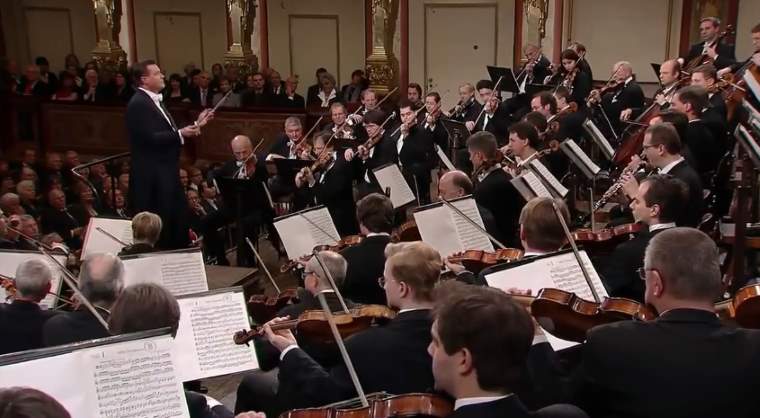Conducted by Christian Thielemann, The Wiener Philharmoniker (Vienna Philharmonic Orchestra) plays Ludwig van Beethoven’s Symphony No. 7 in A major, Op. 92.
Ludwig van Beethoven’s Symphony No. 7 in A major, Op. 92
Beethoven composed his 7th symphony between 1811 and 1812 while improving his health in the Bohemian spa town of Teplice. The work is dedicated to Count Moritz von Fries.
Beethoven’s Symphony No. 7 is named “The Apotheosis of Dance” by the German composer Richard Wagner.
The Seventh Symphony’s premiere concert was performed on December 8, 1813, to benefit the soldiers wounded a few months earlier in the battle of Hanau. It was one of Beethoven’s most successful concerts. The second movement, Allegretto, was the most popular movement and had to be encored. Even today, the second movement remains extremely popular and is often performed separately.
The Symphony No. 7 in A major, Op. 92 is scored for 2 flutes, 2 oboes, 2 clarinets in A, 2 bassoons, 2 horns in A (E and D in the inner movements), 2 trumpets in D, timpani, and strings.
The Seventh Symphony of Beethoven is in four movements:
- Poco sostenuto – Vivace. The first movement starts with a slow introduction – Poco sostenuto – solemn and majestic in character. Then, on the rhythmical background we hear the motif of Part I. This first part brings many new elements, hard to decipher, because perfection expressed through sounds cannot be translated into words.
- Allegretto. Like the opening movement of his Fifth Symphony, the Allegretto of the Seventh is an astounding example of how Beethoven could fashion a vast world from the humblest of materials. Historically, it was the most celebrated movement by far. The audience at the premiere clamored for it to be repeated, and Richard Freed reports that it was so notoriously popular throughout the following two decades that it sometimes was substituted for the slow movements of Beethoven”s earlier symphonies. While in the first part the A major sonorities conferred greatness and sumptuousness, the theme in Part II, in A minor, brings a whole new atmosphere, thus emphasizing the contrast between the two.
- Presto – Assai meno presto (trio). The third movement represents a splendid triumph in rendering the scherzo form. As a whole, it conveys a genuine bucolic scene with pictural meanings and associations. In Trio, the composer uses a theme from an Austrian folkloric song, the theme of which had been jotted down while Beethoven was in Teplitz.
- Allegro con brio . The finale of the Symphony No. 7 manages an immense joy from beginning to the end. Practically, this is the point where dance begins. Everything is captured by movement like a popular folkloric song. The second theme is in fact a typical tune from a Hungarian dance. The great Russian composer Pyotr Ilyich Tchaikovsky thought that this segment captures “a whole series of images, full of unrestrained joy, full of bliss and pleasure of life”. Listening to this symphony’s grand finale one can hardly decide what to think more astonishing: Beethoven’s amazing creative fantasy, the impeccable form, the amazing talent in using all the musical resources in developing the themes or his compact, luscious, sumptuous instrumentation. A profusion of secondary themes obsessively hammer home forceful figures, dotted accents and sustained notes, all reminiscent of the elements animating the prior movements but now concentrated and cohesively united. The movement, and the entire symphony, culminates in a final brickbat at customary expression – the first use of a startling triple forte (fff) in any of Beethoven’s scores.
Sources
- Symphony No. 7 (Beethoven) on W
ikipedia - Beethoven Symphony No. 7 on the classicalnotes.net



I see only two women in this orchestra. What a shame.
Thanks for your comment, Frances. Yes it’s a shame, there should be more women, the ratio should be at least 50%-50%.
So what! Maybe the women are at home looking after their babies and children and introducing them to Beethoven!